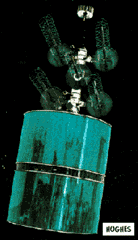TACSAT
 TACSAT was designed to experimentally test and develop tactical communications concepts for all US military services. The mission evaluated the feasibility of using satellite communication repeaters with small surface terminal communication equipment for highly mobile land, sea and air forces. The project was led by the USAF Space and Missile Systems Organization (SAMSO).
TACSAT was designed to experimentally test and develop tactical communications concepts for all US military services. The mission evaluated the feasibility of using satellite communication repeaters with small surface terminal communication equipment for highly mobile land, sea and air forces. The project was led by the USAF Space and Missile Systems Organization (SAMSO).
Spacecraft
Cylindrical shaped aluminum structure with passive thermal control. Spin stabilized (54 rpm) to 0.1 deg using new gyrostat technique. Body mounted solar cells generated 980 W max. Three NiCd batteries with 6 AHr each.
Payload
The vehicle carried two transponders, one at X-band and one at UHF. The X-band transponder had a bandwidth of 10 Mhz and a maximum RF power of 30 watts. The UHF transponder had a
bandwidth of 10 Mhz and a maximum RF output of 230 watts. Provision was made for cross strapping the UHF and X-band up and downlinks with a reduced usable bandwidth of 425 kHz.
Earth coverage horn antennas were used at X-band, bifilar helices were used at UHF.
| Country of Origin | United States |
| Customer/User | USAF/SAMSO |
| Manufacturer(s) | Hughes |
| Size | Cylinder: 3.4 m tall, 3 m diameter |
| Orbit | Geosynchronous |
| Design Life | 46 months |
Launch Facts
| Name | Int'l Desig. | Date | Site | Vehicle | Orbit | Mass(kg) |
| Notes | ||||||
| Tacsat 1 (Tacomsat) | 1969-013A | 2/9/69 | ESMC | Titan 3C | 730 | |
| Experimental commsat | ||||||
Information in The Mission and Spacecraft Library is provided without warranty or guarantee. USE AT YOUR OWN RISK.